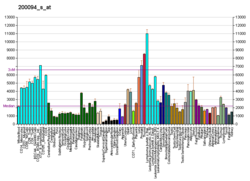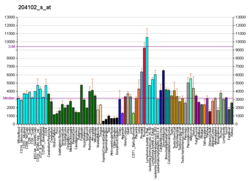eEF2
表示
eEF2(eukaryotic elongation factor 2)は、ヒトではEEF2遺伝子によってコードされているタンパク質である。真核生物のeEF2ならびに古細菌のaEF2は、細菌におけるEF-Gに相当する因子である[5][6][7][8]。
eEF2は、GTP結合型翻訳伸長因子ファミリーに属する。このタンパク質はタンパク質合成に必須の因子であり、リボソームのGTP依存的トランスロケーションを促進する。また、このタンパク質はeEF2キナーゼによるリン酸化によって完全に不活性化される[7]。
ヒトを含む大部分の古細菌や真核生物にみられるaEF2/eEF2には、ヒスチジン残基の翻訳後修飾によって形成されたジフタミド残基が含まれている。この残基はジフテリア毒素(ジフテリア菌Corynebacterium diphtheriae由来)や外毒素A(緑膿菌Pseudomonas aeruginosa由来)の標的となっている[9]。これらの毒素によるeEF2の不活性化によって宿主のタンパク質合成は阻害され、感染細胞の機能喪失に伴う症状が引き起こされることとなる。
出典
[編集]- ^ a b c GRCh38: Ensembl release 89: ENSG00000167658 - Ensembl, May 2017
- ^ a b c GRCm38: Ensembl release 89: ENSMUSG00000034994 - Ensembl, May 2017
- ^ Human PubMed Reference:
- ^ Mouse PubMed Reference:
- ^ “Complete sequence of the coding region of human elongation factor 2 (EF-2) by enzymatic amplification of cDNA from human ovarian granulosa cells”. Biological Chemistry Hoppe-Seyler 370 (10): 1071–5. (October 1989). doi:10.1515/bchm3.1989.370.2.1071. PMID 2610926.
- ^ “Chromosomal assignment of the gene for human elongation factor 2”. Proceedings of the National Academy of Sciences of the United States of America 81 (10): 3158–62. (May 1984). Bibcode: 1984PNAS...81.3158K. doi:10.1073/pnas.81.10.3158. PMC 345240. PMID 6427766.
- ^ a b “Entrez Gene: EEF2 eukaryotic translation elongation factor 2”. 2024年11月10日閲覧。
- ^ “Complex Evolutionary History of Translation Elongation Factor 2 and Diphthamide Biosynthesis in Archaea and Parabasalids”. Genome Biology and Evolution 10 (9): 2380–2393. (September 2018). doi:10.1093/gbe/evy154. PMC 6143161. PMID 30060184.
- ^ “The life and death of translation elongation factor 2”. Biochemical Society Transactions 34 (Pt 1): 1–6. (February 2006). doi:10.1042/BST20060001. PMID 16246167.
関連文献
[編集]- “Construction of a plasmid containing the complete coding region of human elongation factor 2”. Biological Chemistry Hoppe-Seyler 373 (4): 201–4. (April 1992). doi:10.1515/bchm3.1992.373.1.201. PMID 1596361.
- “Kinetic determination of the effects of ADP-ribosylation on the interaction of eukaryotic elongation factor 2 with ribosomes”. The Journal of Biological Chemistry 265 (11): 6030–4. (April 1990). doi:10.1016/S0021-9258(19)39286-5. PMID 2318846.
- “Cloning and sequence analysis of a cDNA from human ovarian granulosa cells encoding the C-terminal part of human elongation factor 2”. Biological Chemistry Hoppe-Seyler 369 (4): 247–50. (April 1988). doi:10.1515/bchm3.1988.369.1.247. PMID 2840927.
- “Regional assignment of five genes on human chromosome 19”. Chromosoma 95 (1): 8–12. (1987). doi:10.1007/BF00293835. PMID 3034518.
- “Identification of the major Mr 100,000 substrate for calmodulin-dependent protein kinase III in mammalian cells as elongation factor-2”. The Journal of Biological Chemistry 262 (36): 17299–303. (December 1987). doi:10.1016/S0021-9258(18)45377-X. PMID 3693353.
- “Study of localization of the protein-synthesizing machinery along actin filament bundles”. Cell Biology International 17 (4): 409–16. (April 1993). doi:10.1006/cbir.1993.1079. PMID 8318952.
- “Regulation of elongation factor-2 by multisite phosphorylation”. European Journal of Biochemistry 213 (2): 689–99. (April 1993). doi:10.1111/j.1432-1033.1993.tb17809.x. PMID 8386634.
- “Stress-induced regulation of eukaryotic elongation factor 2 kinase by SB 203580-sensitive and -insensitive pathways”. The Biochemical Journal 367 (Pt 2): 525–32. (October 2002). doi:10.1042/BJ20020916. PMC 1222910. PMID 12171600.
- “Cytoplasmic complex of p53 and eEF2”. Journal of Cellular Physiology 196 (3): 474–82. (September 2003). doi:10.1002/jcp.10329. PMID 12891704.
- “Characterization of the protein kinase activity of TRPM7/ChaK1, a protein kinase fused to the transient receptor potential ion channel”. The Journal of Biological Chemistry 279 (5): 3708–16. (January 2004). doi:10.1074/jbc.M308820200. PMID 14594813.
- “Large-scale characterization of HeLa cell nuclear phosphoproteins”. Proceedings of the National Academy of Sciences of the United States of America 101 (33): 12130–5. (August 2004). Bibcode: 2004PNAS..10112130B. doi:10.1073/pnas.0404720101. PMC 514446. PMID 15302935.
- “High hydrostatic pressure inhibits the biosynthesis of eukaryotic elongation factor-2”. Journal of Cellular Biochemistry 94 (3): 497–507. (February 2005). doi:10.1002/jcb.20333. PMID 15534876.
- “Nucleolar proteome dynamics”. Nature 433 (7021): 77–83. (January 2005). Bibcode: 2005Natur.433...77A. doi:10.1038/nature03207. PMID 15635413.
- “Proteomic analysis of mammalian oligosaccharyltransferase reveals multiple subcomplexes that contain Sec61, TRAP, and two potential new subunits”. Biochemistry 44 (16): 5982–92. (April 2005). doi:10.1021/bi047328f. PMID 15835887.
- “Protein profiling of human pancreatic islets by two-dimensional gel electrophoresis and mass spectrometry”. Journal of Proteome Research 4 (3): 931–40. (2005). doi:10.1021/pr050024a. PMID 15952740.
- “Global phosphoproteome analysis on human HepG2 hepatocytes using reversed-phase diagonal LC”. Proteomics 5 (14): 3589–99. (September 2005). doi:10.1002/pmic.200401217. PMID 16097034.






